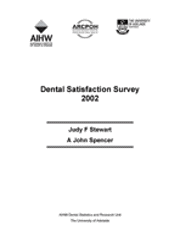Summary
The specific aims of the 2002 Dental Satisfaction Survey were to examine differences in the levels of satisfaction with dental care in a cross-sectional survey and to extend the available data for examining changes over time in the dental satisfaction levels of health cardholders, particularly those receiving public-funded dental care.
The Dental Satisfaction Survey was developed as part of the evaluation of the Commonwealth Dental Health Program, and has been conducted jointly with the National Dental Telephone Interview Survey (NDTIS) in 1994, 1995, 1996, and 1999 and 2002 to monitor adult access to dental care in Australia.
Satisfaction with health care is regarded as an intermediate outcome of the health care process that reflects the extent to which the care given answers patients' needs, meets their expectations and provides an acceptable standard of service.
Three dimensions of satisfaction with dental care were initially incorporated in the questionnaire designed for this Survey: the context of the dental visit; the content of the dental visit and the outcome of the dental visit. The additional dimensions of satisfaction with the cost or affordability of dental care and satisfaction with facilities were included in 1995 and subsequent Dental Satisfaction Surveys.
The questionnaire was mailed to a sample of participants in the 2002 National Dental Telephone Interview Survey.
The 2002 survey was conducted in all States and Territories, and included a total of 1543 dentate adults who had made a dental visit within the previous 12 months, representing a response rate of 72.8%. The data were weighted to represent the age and sex distribution of the Australian population.
Responses to the individual items of the Dental Satisfaction Survey indicated overall levels of satisfaction, although implicit dissatisfaction was expressed with cost and affordability items. The highest levels of satisfaction were expressed for the friendliness of the clinic staff, the explanation of treatment needs and that the surgery was well-equipped.
The lowest levels of satisfaction were recorded for explanation of treatment options and cost-related items - unnecessary costs, affordability of care, and feeling financially protected against dental expenses.
There was significantly greater satisfaction with all aspects of the dental visit ie. the context, the content, the outcome and overall satisfaction, among older age groups. Significantly lower levels of satisfaction with all aspects of the dental visit were evident where a language other than English was spoken at home, where the respondents reported poorer oral health or financial constraints, problem-oriented visiting patterns, and by those respondents whose last visit was to a public clinic.
The Dental Satisfaction Surveys had been directed towards an assumed difference between the satisfaction of health cardholders and non-cardholders. While this difference was significant, even larger differences existed by place of last visit.
The greatest variation in satisfaction between those respondents who had visited a public clinic and those who visited a private practice was on the outcome scale, which addressed issues services received and service results.
The highest mean satisfaction score on the cost/affordability scale occurred among cardholders who last attended a public clinic.
Lower levels of satisfaction with the affordability of dental care were associated with younger age groups, cardholders who last received care at a private practice at their own expense, a language other than English at home, being born overseas, lack of dental insurance, and the financial constraints of accessing dental care.
The cross-sectional nature of this Survey has shown that there were differences in satisfaction levels between groups at the time of the Survey and has generated a base for examining changes in satisfaction levels over time by comparing surveys collected at different periods which may be related to changes in provision of dental care to health cardholders.
A valuable indicator of the performance of public sector delivery of dental care will be the investigation, in future years, of changes in satisfaction levels. As changes occur in co-payment policies and/or the dental care made available in the public sector (in the States and Territories), or health cardholders receive subsidised dental care in the private sector, satisfaction levels are likely to change.
Satisfaction levels changed during the period 1994-96, as expected, as increased dental care was made available to eligible cardholders both in the public sector and subsidised dental care in the private sector. Substantial increases occurred, which, while not significant at the sub-scale level, a number of individual items showed significant gains in satisfaction among cardholders who received public-funded care.
Further surveys at regular intervals would be desirable to monitor future changes in dental satisfaction in the Australian population, particularly among cardholders who are eligible for public-funded dental care.



